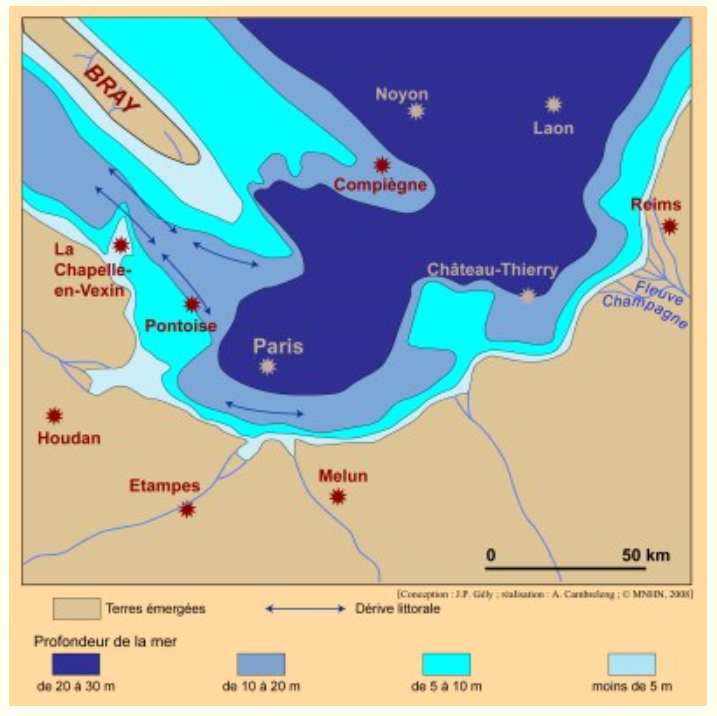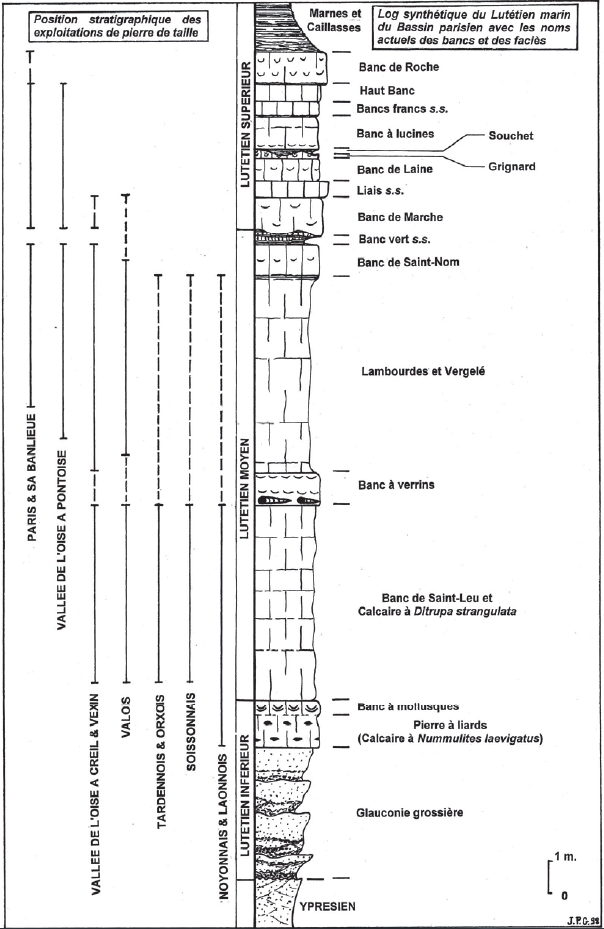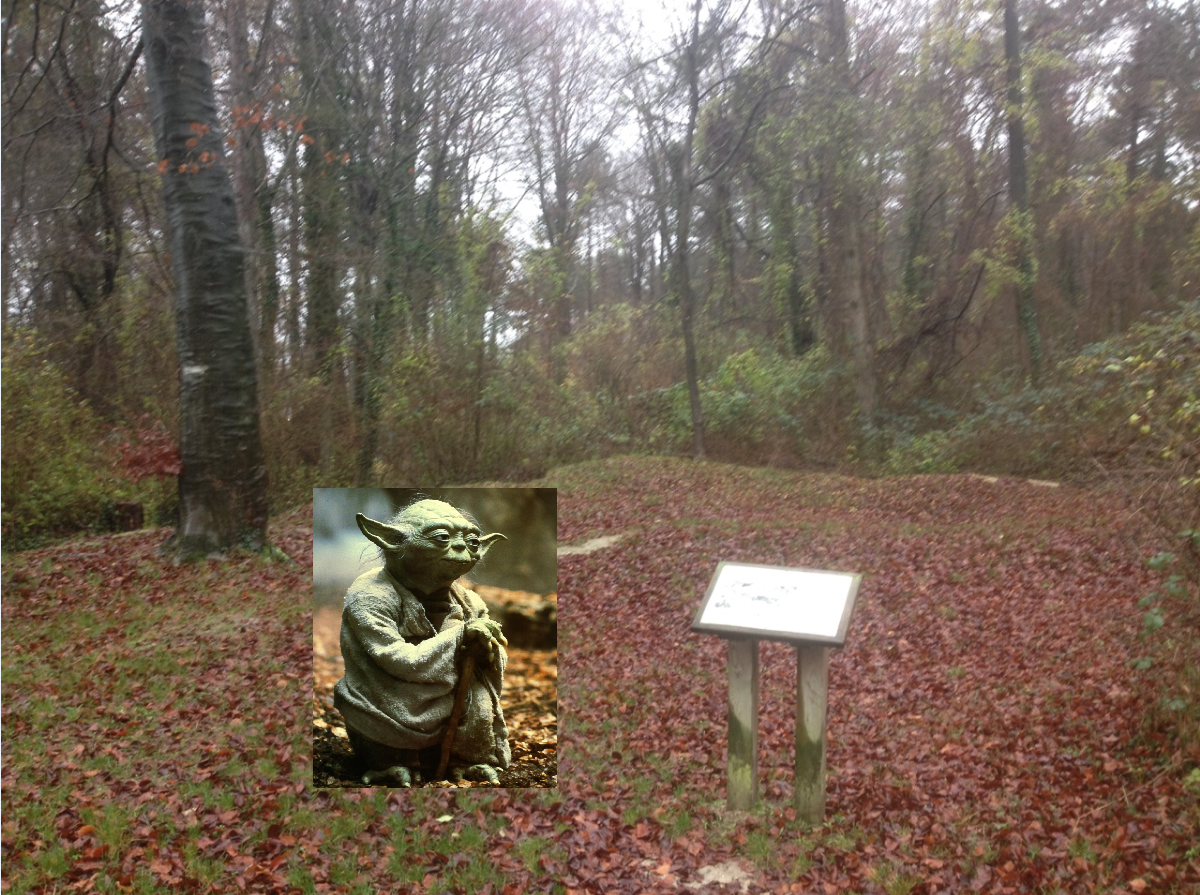
Histoire du Lutétien
Le stratotype du Lutétien a été identifié par Albert de Lapparent à la fin du XIXe siècle. C'est un âge de l'Eocène, entre 48,5 et 40,5 Ma avant notre ère, venant après l'Yprésien et avant le Bartonien. Pendant ces 8 millions d'années, le Bassin parisien a subi de profonds bouleversements et connu trois cycles transgression-régression de la mer.
Au Lutétien inférieur, la mer envahit le golfe parisien par le Nord (transgression). Elle arrive d'abord au niveau Noyon/Laon, puis à Paris et s'arrête au niveau de Melun/Etampes. Au Lutétien moyen, un mouvement inverse se produit (régression) et la mer se retire vers le Nord-Ouest. Entre les deux épisodes, la formation des Pyrénées a créé des plissements dont celui du dôme de l'Artois qui coupe la communication avec la mer du Nord à la fin du Lutétien moyen.
Les premiers sédiments du Lutétien sont déposés dans une eau marine peu profonde, de l'ordre d'une dizaine de mètres, agitée, et alimentée par les dépôts détritiques des rivières. Ils forment la glauconie grossière.
Avec la transgression, la profondeur d'eau augmente (jusqu'à une cinquantaine de mètres), l'agitation diminue et les dépôts de coquilles de mollusques sont de plus en plus importants. Ces conditions sont favorables aux sédiments calcaires (pierre à liards, banc de Saint-Leu, etc.).
Carte paléogéographique du bassin de Paris au dépôt du banc de Saint-Leu

Coupe stratigraphique simplifiée du Lutétien

Validation de la cache
1- Au coordonnées de la cache , vous allez découvrir la coupe d'un flanc de talus. Quelle type de roche pouvez-vous observer ici ?
2- expliquez la présence de cette roche dans le bassin parisien
3- En regardant de plus près, vous pourrez même déterminer à quel époque du lutétien (inférieur, moyen ou supérieur) cette roche fait partie. De quelle époque s'agit-il ? expliquez votre réponse.
4- donnez l'altitude mesurée devant le flanc
5- Rendez-vous au WP1 et observez la photo ci-dessous. Que cache Yoda ?

6- Vous pouvez également ajouter à votre log une photo de vous ou de votre GPS sur place (ceci n'est pas obligatoire mais pourrait permettre de valider la cache en cas de réponses trop éloignées de la réalité en confirmant votre présence sur les lieux).

History Lutetian
The stratotype Lutétien was identified by Albert Lapparent in the late nineteenth century. This is an age of the Eocene, between 48.5 and 40.5 Ma BC, coming after Ypresian and before Bartonian. During these 8 million years, the Paris Basin has undergone profound changes and experienced three transgression-regression cycles to the sea.
In early Lutetian, the sea invades the Parisian Gulf by the North (transgression). It first arrives at Noyon / Laon, then to Paris and stop at Melun / Etampes. Through Lutetian, a reverse movement occurs (regression) and the sea withdrew to the northwest. In between episodes, the formation of the Pyrenees has created folds including that of the Artois dome that cuts communication with the North Sea in the late Middle Lutetian.
The first Lutetian sediments are deposited in a shallow sea water, on the order of ten meters, agitated, and fed by detritus of rivers. They form the coarse glauconite.
With transgression, the water depth increases (up to fifty meters), agitation decreases and mollusc shells deposits are increasingly important. These conditions are favorable to calcareous sediments (lion stone bench of Saint-Leu, etc.).
Paleogeographic map of the Paris Basin to the deposit of the bank of Saint-Leu

Simplified stratigraphic section Lutetian

Validation of the cache
1- At the coordinates of the cache, you will discover the cutting edge of a slope. What type of rock can you watch here ?
2- explain the presence of this rock in the Paris basin
3- Looking more closely, you can even determine at what time of the Lutetian (lower, middle and upper) this rock belongs. What time is it? Explain your answer.
4- give the altitude measured at the side
5- Meet at WP1 and look at the photo below . What is behind Yoda ?

6- You may also be added to your log a photo of you or your GPS on site (this is not mandatory but could help validate the cached responses case too far from reality confirming your presence at the scene).